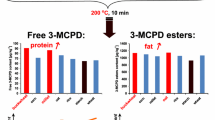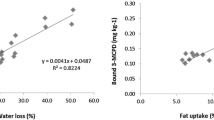Abstract
This study evaluates the content and formation of free and bound monochloropropanediol (MCPD) and bound glycidol (GE) in fine bakery wares from the German market. The analytical screening revealed, that free 3-MCPD can be quantified in products with low water and fat content, which are produced using high baking temperatures. Concentrations resulted to be 10.0 µg/kg (wafers), 14.1 µg/kg (crispbread) and 22.8 µg/kg (rusk) and are thus judged to be of minor significance when it comes to a potential introduction of a combined maximum level for free and bound species. As exception, considerable amounts of free 3-MCPD (maximum level of 265.4 µg/kg) were only quantified in cinnamon stars containing glycerine as additive. As expected, MCPDE were only quantified in products produced with refined vegetable oil (short bread, puff pastry, caramel biscuits, speculoos, cake, wafers, wholemeal biscuits and rusk). GE levels have already been significantly reduced compared to former studies, one cake showed a maximum content of 127.8 µg/kg. A model baking trial using 13C-3-MCPDE spiked butter as fat component in shortbread confirmed that free 3-MCPD and 2-MCPD, 3-MCPDE, 2-MCPDE or GE are not endogenously formed in marketable browned biscuits. A thermal or lipase-catalysed release of free 3-MCPD from its fatty acid esters can be excluded.




Similar content being viewed by others
References
Hamlet CG, Sadd PA (2009) Chloropropanols and Chloroesters. In: Stadler RH, Lineback DR (eds) Process-induced food toxicants: occurence, formation, mitigation, and health risks. Wiley, Hoboken
Svejkovská B, Novotny O, Divinova V, Reblova Z, Doležal M, Velíšek J (2004) Esters of 3-chloropropane-1,2-diol in foodstuff. Czech J Food Sci 22(5):190–196
Zelinková Z, Svejkovská B, Velíšek J, Doležal M (2006) Fatty acid esters of 3-chloropropane-1,2-diol in edible oils. Food Addit Contam A 23(12):1290–1298
Abraham K, Appel KE, Berger-Preiss E, Apel E, Gerling S, Mielke H, Creutzenberg O, Lampen A (2013) Relative oral bioavailability of 3-MCPD from 3-MCPD fatty acid esters in rats. Arch Toxicol 87(4):649–659
Appel KE, Abraham K, Berger-Preiss E, Hansen T, Apel E, Schuchardt S, Vogt C, Bakhiya N, Creutzenberg O, Lampen A (2013) Relative oral bioavailability of glycidol from glycidyl fatty acid esters in rats. Arch Toxicol 87(9):1649–1659
International Agency for Research on Cancer (2016) Monographs on the evaluation of carcinogenic risk to humans: some chemicals present in industrial and consumer products, food and drinking-water. 3-Monochloro-1,2-propanediol. https://monographs.iarc.fr/wp-content/uploads/2018/06/mono101-010.pdf. Accessed 06 Feb 2020
Knutsen HK, Alexander J, Barregård L, Bignami M, Brüschweiler B, Ceccatelli S, Cottrill B, Dinovi M, Edler L, Grasl-Kraupp B, Hoogenboom L, Nebbia CS, Oswald IP, Petersen A, Rose M, Roudot A-C, Schwerdtle T, Vleminckx C, Vollmer G, Wallace H, Lampen A, Morris I, Piersma A, Schrenk D, Binaglia M, Levorato S, Hogstrand C (2018) Update of the risk assessment on 3-monochloropropane diol and its fatty acid esters. EFSA J 16(1):407
International Agency for Research on Cancer (2000) Some industrial chemicals IARC monographs on the evaluation of carcinogenic risks to humans. https://publications.iarc.fr/Book-And-Report-Series/Iarc-Monographs-On-The-Identification-Of-Carcinogenic-Hazards-To-Humans/Some-Industrial-Chemicals-2000. Accessed 06 Feb 2020
Commission E (2018) Commission Regulation (EU) 2018/290 of 26 February 2018 amending Regulation (EC) No 1881/2006 as regards maximum levels of glycidyl fatty acid esters in vegetable oils and fats, infant formula, follow-on formula and foods for special medical purposes intended for infants and young children. OJEU L55:27–29
European Commission (2020) DRAFT: ANNEX to the Commission regulation (EU) …/…amending Regulation (EC) 1881/2006 as regards maximum levels of 3-monochloropropanediol (3-MCPD), 3-MCPD fatty acid esters and glycidyl fatty acid esters in certain foods. https://data.consilium.europa.eu/doc/document/ST-7974-2020-ADD-1/en/pdf. Accessed 31 May 2020
Weißhaar R (2011) Fatty acid esters of 3-MCPD: overview of occurrence and exposure estimates. Eur J Lipid Sci Technol 113(3):304–308
Nagy K, Sandoz L, Craft BD, Destaillats F (2011) Mass-defect filtering of isotope signatures to reveal the source of chlorinated palm oil contaminants. Food Addit Contam A 28(11):1492–1500
Sadowska-Rociek A, Cieślik E (2016) Changes of 3-monochloropropane-1,2-diol levels in crackers and biscuits during storage. J Verbr Lebensm 11(4):317–324
Velíšek J, Doležal M, Crews C, Dvořák T (2002) Optical isomers of chloropropanediols: mechanisms of their formation and decomposition in protein hydrolysates. Czech J Food Sci 20(5):161–170
Yu L, Wang S, Sun B (2017) Food safety chemistry: toxicant occurrence, analysis and mitigation. CRC Press, Boca Raton
Hamlet CG, Asuncion L, Velíšek J et al. (2014) Investigation of the formation of 3-chloropropane-1–2-diol (3-MCPD) from mono- and di-esters of its fatty acids in foods (FS231006, FS231074, FS231075). https://www.food.gov.uk/sites/default/files/media/document/C04072_Final%2520report_July%25202014_151014.pdf. Accessed 29 Jan 2020
Paul R (2005) The origin and formation of 3-MCPD in foods and food ingredients. https://citeseerx.ist.psu.edu/viewdoc/download;jsessionid=E489E6F884B0694C94F70AFB43C292C1?doi=10.1.1.611.8907&rep=rep1&type=pdf. Accessed 09 Mar 2020
Hamlet CG, Sadd PA (2005) Effects of yeast stress and pH on 3-monochloropropanediol (3-MCPD)-producing reactions in model dough systems. Food Addit Contam A 22(7):616–623
The European Parliament and Council (2008) Regulation (EC) No 1331/2008 The European Parliament and Council of 16 December 2008 establishing a common authorisation procedure for food additives, food enzymes and food flavourings. OJEU L354:1–6
Hamlet CG, Sadd PA, Gray DA (2004) Generation of monochloropropanediols (MCPDs) in model dough systems. 1. Leavened doughs. J Agric Food Chem 52(7):2059–2066
Cheng W-w, Liu G-q, Wang L-q, Liu Z-s (2017) Glycidyl fatty acid esters in refined edible oils: a review on formation, occurrence, analysis, and elimination methods. Compr Rev Food Sci Food Saf 16(2):263–281
Destaillats F, Craft BD, Dubois M, Nagy K (2012) Glycidyl esters in refined palm (Elaeis guineensis) oil and related fractions Part I: Formation mechanism. Food Chem 131(4):1391–1398
Cheng W, Liu G, Liu X (2016) Formation of glycidyl fatty acid esters both in real edible oils during laboratory-scale refining and in chemical model during high temperature exposure. J Agric Food Chem 64(29):5919–5927
Craft BD, Nagy K, Seefelder W, Dubois M, Destaillats F (2012) Glycidyl esters in refined palm (Elaeis guineensis) oil and related fractions. Part II: practical recommendations for effective mitigation. Food Chem 132(1):73–79
Dingel A, Matissek R (2015) Esters of 3-monochloropropane-1,2-diol and glycidol: no formation by deep frying during large-scale production of potato crisps. Eur Food Res Technol 241(5):719–723
Dingel A, Matissek R (2017) No endogenous formation of MCPD fatty acid esters and glycidyl fatty acid esters during the baking process of fine bakery wares. Dtsch Lebensmitt Rundsch 113:511–515
Kuhlmann J (2019) 2-Monochloropropanediol (2-MCPD), 3-monochloropropanediol (3-MCPD), and glycidol in Infant and adult/pediatric nutritional formula: single-laboratory validation, first action 201812. J AOAC Int 102(4):1205–1220
European Commission (2019) Commission Implementing Regulation (EU) 2019/2093 of 29 November 2019 amending Regulation (EC) No 333/2007 as regards the analysis of 3-monochloropropane-1,2-diol (3-MCPD) fatty acid esters, glycidyl fatty acid esters, perchlorate and acrylamide. OJEU L317:96-101
Raters M, Matissek R (2018) Acrylamide in cocoa: a survey of acrylamide levels in cocoa and cocoa products sourced from the German market. Eur Food Res Technol 244(8):1381–1388
German Food Code (2010) Guideline for fine bakery products (Leitsätze für Feine Backwaren). GMBl(5/6): 120 ff
Mogol BA, Pye C, Anderson W, Crews C, Gökmen V (2014) Formation of monochloropropane-1,2-diol and its esters in biscuits during baking. J Agric Food Chem 62(29):7297–7301
Acknowledgements
We thank Nadine Karcher and Francesca Zamolo for their excellent technical support.
Author information
Authors and Affiliations
Corresponding author
Ethics declarations
Conflict of interest
The authors declare that there is no conflict of interest.
Compliance with ethics requirements
This article does not contain any study with human or animal objects.
Additional information
Publisher's Note
Springer Nature remains neutral with regard to jurisdictional claims in published maps and institutional affiliations.
Rights and permissions
About this article
Cite this article
Stauff, A., Schneider, E. & Heckel, F. 2-MCPD, 3-MCPD and fatty acid esters of 2-MCPD, 3-MCPD and glycidol in fine bakery wares. Eur Food Res Technol 246, 1945–1953 (2020). https://doi.org/10.1007/s00217-020-03546-4
Received:
Revised:
Accepted:
Published:
Issue Date:
DOI: https://doi.org/10.1007/s00217-020-03546-4




